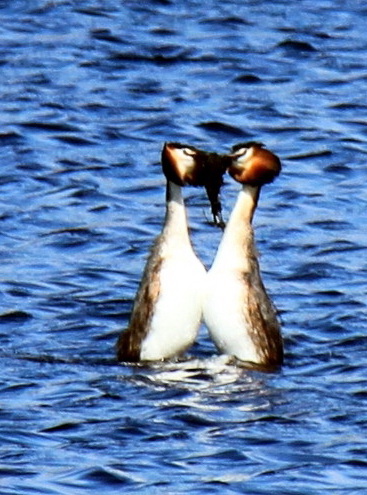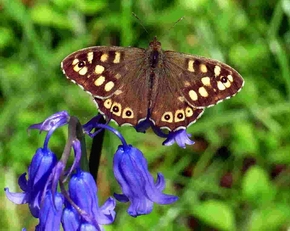When to Watch Wildlife |
J | F | M | A | M | J | J | A | S | O | N | D | Search |
Current wildlife highlights |
||
|
What's new on this site |
||
|
Wildlife calendar |
||
|
Plants and Animals |
||
|
Habitats |
||
|
Wildlife sites |
||
|
WWW links |
||
|
Guide Books |
||
 |
||
|
© PMcS 2006 |
|
April |
||||||||||||||||||||||||||||
|
||||||||||||||||||||||||||||
|
This month look out for:
|
||||||||||||||||||||||||||||
April is a
fabulous month for wildlife, as the trees and shrubs burst into leaf
with fresh, vibrant green foliage. The fragile leaves are
vulnerable to insect attack, but this early growth is still beautiful
perfection. Bird song grows in volume and diversity in April,
although it is not until May that all our breeding species arrive back
to complete the ensemble. However early morning sleep can be
disturbed by a strident blackbird or song thrush. In
the countryside on sunny days the chiff-chaff and blackcap
will already have been singing for a week or two.
In the woodland, the floor can be a mass of white wood anemone, ramsons flowers, and slightly later a blue carpet packed with bluebells. It is possible to catch their heady scent even before you are under the filling treetop canopy. The woodland flowers need to be pollinated and catch the available light to grow before the darkness envelops them. This is why they grow so early and then slowly die back in summer. In the meadows the cuckoo flower, green winged orchid, cowslip and adders tongue emerge.
On a few selected flood plain sites, in late April, the huge drifts of the delicate snake's head fritillary provide a breath taking spectacle.
The downlands are also starting to display a few specialities such as the pasque flower. Along with meadows, the unimproved chalk and limestone grassland support the more common, but nevertheless attractive yellow heads of the cowslip with their honey scent. The overwintering bird visitors such as redwings and fieldfares leave in April, as do visiting swans, geese and waders. The summer visiting birds that arrive to replace them include house martins and many warblers such a whitethroats, marsh, sedge and willow warblers. The three birds that also return, and perhaps most signify summer, are the swallow, the nightingale and the one so eagerly awaited by The Times readers - the cuckoo. During this period of migration, certain departure\arrival points on the coast become bird watcher's Meccas as they provide quite a spectacle. Some resident bird species may also have their first bird broods such as blue tits and blackbirds. In the ponds the frog spawn and toad eggs can be found in large quantities. These species have becoming more and more dependant on gardens, as their previous strongholds of farmland ponds have largely disappeared.
|
||||||||||||||||||||||||||||
| Habitats and species |
||||||||||||||||||||||||||||
|
Parks and gardens: As the garden comes alive once more as the soil
warms up and insects such as bees, tortoise shell butterflies and
peacocks flit between the flower. They may be found basking
in the sun to absorb its warmth. The dawn chorus is in full swing,
with the occasional singing of birds during the rest of the day such as
greenfinch, woodpigeon and collared doves from the
roof tops. To help workout which bird is singing go to the
bird song page
for further hints. |
||||||||||||||||||||||||||||
|
Woodlands
(including wood pasture): see introduction above. On sunny
days you may see the pale yellow brimstone butterfly in the woodland
glades or alighting on a primrose to feed on nectar. It is one of
the earliest butterflies to emerge having spent the winter in the adult
stage. The caterpillars only feed on buckthorn and alder
buckthorn. In some old woodlands clumps of native wild daffodil still survive. Do not be fooled by planted garden varieties. Their wild ancestors are all yellow with smallish flowers. The central trumpet is quite cylindrical.
|
||||||||||||||||||||||||||||
Arable and hedgerows: One of the hardy flowers that is first to
bloom and can be seen all year round is the red dead-nettle.
Also the common annual sheppard's purse quickly flowers and sets
seed.
|
||||||||||||||||||||||||||||
|
Road verges: Lords and Ladies show their unusual and
distinctive 'flower' in April and May. The central column attracts
flies which enter the flower and pick up pollen to take to another
plant. Cleavers also grows quickly and will soon be winding
its stems up through the other vegetation. Dandelion
flowers are amongst the first to appear in the hedgerows, and this
otherwise common plant can show off its complex yellow flowers without
fear of being outshone by other more glamorous species. |
||||||||||||||||||||||||||||
Chalk and limestone grasslands: The cowslips are amongst the
first of the flowering plants found on downland and limestone.
Their yellow drooping bell flowers can cover hillsides and if you get up
close to the flowers you may be able to pick up a delicate honey-like
scent.
Along with cowslips and hairy violet, on a few sites,
the rare
pasque flower and spring gentian can also be found
in April and are well worth a special trip to see. |
||||||||||||||||||||||||||||
Meadows (neutral) and flood plain grasslands: The unusual and
rather small adders tongue fern can be found in old meadows but is very
hard to spot.
|
||||||||||||||||||||||||||||
|
Acidic grasslands: |
||||||||||||||||||||||||||||
|
Heathlands:
On heathlands the gorse is in full yellow bloom and provides a
very important food source for insects. |
||||||||||||||||||||||||||||
|
Mountain and Moorlands (uplands): |
||||||||||||||||||||||||||||
|
Rivers
and ponds (including bogs and mires): |
||||||||||||||||||||||||||||
|
Sea
and the sea shore (including estuaries): |
||||||||||||||||||||||||||||
|
Mammals:
Badger activity is high by now. Sets will have been spring
cleaned and adults make foraging sorties each night. The young are
born from mid-January to mid-March and remain in the breeding chamber of
eight weeks. Therefore the early young will already be appearing
above ground in April. Weaning may even be complete for these
individuals by the end of this month. As badgers are nocturnal
sightings are rare. |
||||||||||||||||||||||||||||
|
Birds: Many
summer migrants arrive as over wintering species depart. Birds on
migration but which do not normally reside in Britain appear at this
time by accident. These vagrants and passage migrants are keenly
sought after by bird watchers. The dawn chorus is in full swing but only in May do all the singing bird species arrive. On lakes the winter visitors are leaving and this spectacle is being replaced by breeding birds such as great crested grebes performing their elegant and energetic mating "weed dance".
|
||||||||||||||||||||||||||||
|
Amphibians & Reptiles: Frog's spawn has become tadpoles by
April. The adults now leave the ponds to live on land until
Autumn. They feed on slugs, snails and insects and therefore
should be valued by gardeners. Adders and slowworms come out of
hibernation, along with other reptiles. They need to bask for
extended periods in order to get their body temperature up the level
where they can function fully, as they are cold blooded. |
||||||||||||||||||||||||||||
Insects: Late
in April the large black swarming St Mark's fly makes an
appearance. It is a welcome food source for newly arrived migrant
birds as well as residents. It is very noticeable as its longish
black legs lazily trail below as it flies around.
Peacock, orange tip and speckled wood
butterflies appear in April. In the south the yellow brimstone
butterflies will already have been on the wing for several weeks, having
over wintered amongst ivy as adults. Some species of damsel flies
can also be spotted on warm days near open water. |
||||||||||||||||||||||||||||
|
Plants: Ash
trees come into flower in April, but its leaves are one of the last to
emerge (May). The male parts consist of a bundle purple pollen
filled clusters and the females parts are dangle in the air to pick up
wind borne pollen. |
||||||||||||||||||||||||||||
| Fungi | ||||||||||||||||||||||||||||
All images and text are copyright PMcS 2006











